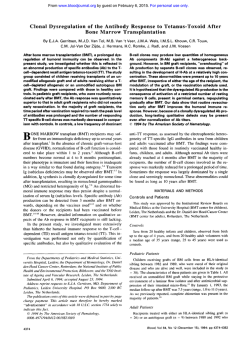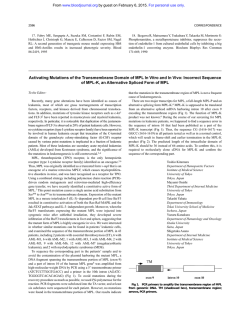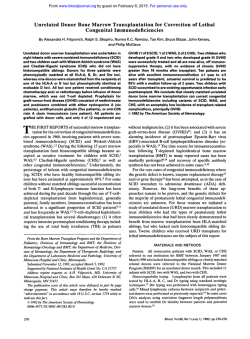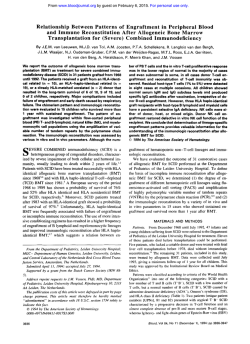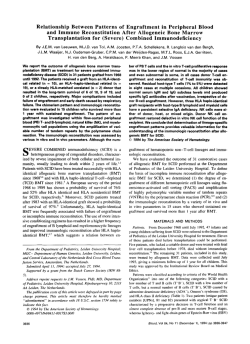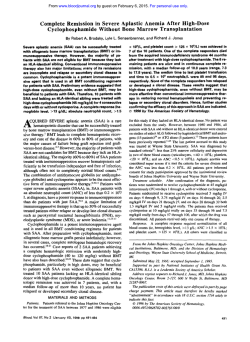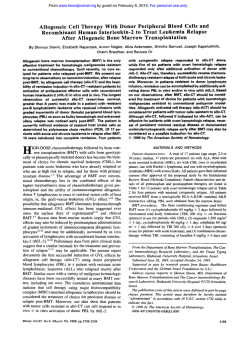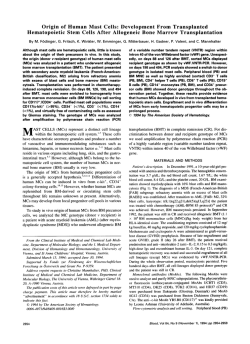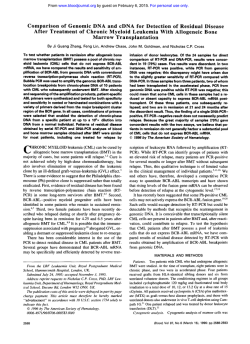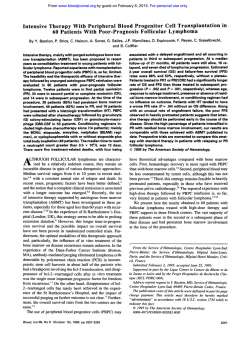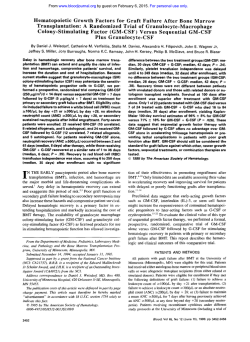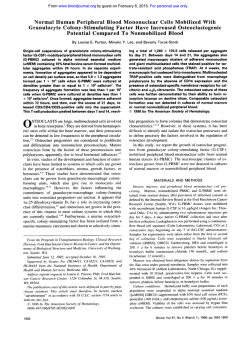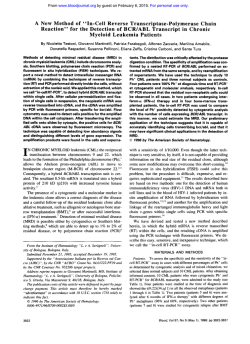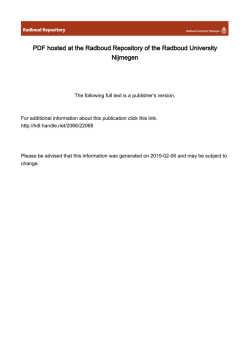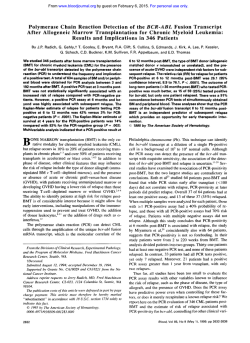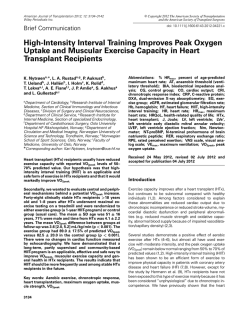
Bone Marrow Transplantation Corrects the Splenic
From www.bloodjournal.org by guest on February 6, 2015. For personal use only. Bone Marrow Transplantation Corrects the Splenic Reticuloendothelial Dysfunction in Sickle Cell Anemia By Alina Ferster, Willem Bujan, Francis Corazza, Christine Devalck, Pierre Fondu, Michele Toppet, Michel Verhas, and Eric Sariban In sickle cell anemia (SCA), the loss of reticuloendothelial function is the result of vasoocclusive events occurring in the spleen. Such asplenia occurs early in the course of the disease and is consideredto be permanent in late childhood. In this report, three patients 10, 11, and 14 years of age suffering from severe SCA and found to be asplenic were treated by bone marrow transplantation (BMT). Before transplantation, all three patients had loss of reticuloendothelial splenic function, as assessed by the presence of abundant Howell-Jolly bodies on blood smears and absence of technetium 99m (99mT~) splenic uptake. After BMT, Howell-Jolly bodies disappeared from blood smear, whereas 99mTcisotopic scan found normal isotope uptake. Our data indicate that BMT can correct "permanent asplenia" in SCA patients. However, it remains to be determined if such treatment can also correct other SCA-related organ dysfunctions. 0 1993 by The American Society of Hematology. T to 1 pm in diameter (Ablu-Res; Solco Nuclear, Sorin Biomedica, Italy). 99mTcemits a monoenergectic gamma ray and its half-life is short (6 hours). Thirty minutes after the injection of 185 MBq (equal to 5 mCi) of Albu-Res, four images (anterior, posterior, right lateral, left lateral) were taken in a supine position, with planar and scan camera (L.F.O.V. Siemens Camera, Germany). The scans were recorded on Polaroid films (RE 667). HE CLINICAL COURSE in sickle cell anemia (SCA) is still marked by a high morbidity rate and increased mortality rate in early adulthood.'-3 Recently, allogenic bone marrow transplantation (BMT) has been investigated as a curative treatment in SCA.4-hIn our institution, patients having developed severe SCA-related events were considered for BMT. Although results of the first transplants are encouraging, controversy still surrounds this modality of treatment approa~h.'.~ In addition, it remains to be determined if such an approach might reverse organ damage resulting from the underlying disease. Functional asplenia is known to develop early in SCA patients' and contribute to disease morbidity and mortality.'.'' Most patients are considered as permanently asplenic when they reach the age of 7 years. We have studied the splenic function in three patients with SCA and have found reversal of such functional asplenia after BMT. PATIENTS AND METHODS Since November 1988, seven children with SCA, aged 2 to 14 years, were selected for BMT in our institution and were treated according to a previously described protocol! Approval was obtained from the Institutional Review Board for these studies. Informed consent was provided according to the Declaration of Helsinki. The three oldest patients (aged 10, 1 1, and 14 years) were carefully investigated for splenic function before and after BMT. Table 1 summarizes the clinical symptoms presented by the three patients before BMT. May-Grunwald-Giemsa-stained blood films were examined for the presence of Howell-Jolly bodies before and after BMT. The technetium 99m (99mTc)sulfur colloid was prepared with particles of 0.2 From the Pediatric Hematology/Oncology Unit, H6pital Universitaire des Enfants Reine Fabiola; and the Department of Nuclear Medecine, H6pital UniversitaireBrugmann, Brussels, Belgium. Submitted September 15, I992, accepted October 20, 1992. Supported by a grant of the Fonds National de la RechercheScientijique (7.4582.90). Address reprint requests to A h a Ferster, MD, Pediatric Hematology/Oncology Unit, H6pital Universitaire des Enfants Reine Fabiola, AV J.J. Crocq IS, I020 Brussels, Belgium. The publication costs of this article were defrayed in part by page charge payment. This article must therefore be hereby marked "advertisement" in accordance with 18 U.S.C. section 1734 solely to indicate this fact. 0 1993 by The American Society of Hematology. OVO6-4971/93/8lV4-0017$3.00/0 1102 RESULTS All three patients engrafted successfully with acceptable early and late toxicity (Table 2). The actual follow-up ranges from 8 to 43 months. All three patients have now hemoglobin levels above 10 g/dL with electrophoretic pattern of donor type. Chromosome studies were noninformative because donor and recipient were of the same sex in each case. Since the time of transplantation, all three patients remain free of new SCA manifestations. Patient 1 developed a limited de novo chronic graft versus host disease (GVHD) that promptly responded to immunosuppressive therapy. Before BMT, no patient had a palpable spleen. Repeated blood smear screenings in all three patients disclosed the presence of numerous Howell-Jolly bodies as well as sickled cells (Fig 1A). Hepatosplenic radionuclide "Tc scintigraphy did not demonstrate splenic uptake (Fig 2A). Furthermore, prior to BMT, patients 2 and 3, suffering from symptomatic vesicular lithiasis, underwent surgery for cholecystectomy. In both cases, the spleen had a fibrosislike appearance at laparotomy. A careful screening of multiple blood smears 3, 6, and 12 months after BMT did not show the presence of Howell-Jolly bodies (Fig IB). In patients 1 and 2, "Tc hepatosplenic scintigraphy performed 1 and 1.5 years after BMT showed the presence of normal size splenic tissue (Fig 2C). In patient 3, a hepatosplenic scintigraphy performed 3 months after BMT already showed the presence of splenic uptake (Fig 2B). DISCUSSION As previously reported by our group, we confirm that BMT in SCA is feasible, with a high cure rate.6 We and others did not see any mortality events related to the transplantation However, morbidity events such as opportunistic infections, hemorrhage, GVHD, graft rejection, lung fibrosis, infertility, or secondary tumors have to be expected. Long-term follow-up of our successful grafted patients shows Blood, Vol81, No 4 (February 15), 1993: pp 1102-1 105 From www.bloodjournal.org by guest on February 6, 2015. For personal use only. CORRECTION OF ASPLENIA IN SCA BY BMT 1103 Table 1. Selection Criteria for BMT Patient No. Age at BMT 1 2 3 10 11 14 (vr) Severe RepetitiveCrises (1) or Acute Chest Syndrome (2) No. of ROC Transfusions During Past Year 1 (1) + (1 and 2) i- (1) 12' 6 7 Stroke Severe Alloimmunization Kamovsky score - - + 70 70 70 + + Chronic transfusionsupport. that they have a stable hemoglobin level and do not suffer from new SCA-related events. Among the seven grafted patients, none developed acute GVHD, one developed a chronic GVHD, and two suffered from graft rejection. However, it remains to be determined if BMT can restore or improve the functions of organs severely damaged by the underlying disease.In thiscontext, we studied splenic function in three patients. Functional asplenia is defined as impaired splenic reticuloendothelial function. This inability to clear particules or microorganisms from blood develops early in the life of patients with SCA? Consequently, these patients are prone to develop microbial infections with a well-known increased risk of pneumococcal sepsis." Functional asplenia is classically defined by (1) the presence of Howell-Jolly bodies in circulating red cells and (2) the absence of reticuloendothelial splenic function, demonstrated by the disappearance of wmTc splenic uptake, even in the presence of a palpable spleen.'2 It was well demonstrated that functional asplenia may reverse after red blood cell (RBC)transfusion in young patients with palpable spleen. This reversible functional asplenia is explained by the fact that blood having a high viscosity bypasses the reticuloendothelial tissue of the spleen through intrasplenic shunts. However, by the age of 7, patients with SCA are considered as permanently asplenic despite RBC transf~sions.'~ At this age, most patients have a small fibrotic Fig 1. Bloodsmear before (A) and after (B) bM I. Numerous sickled cells and Howell-Jdlybodies (arrow) present before BMT in patient 1 (A), have disappeared 3 months after BMT (B). From www.bloodjournal.org by guest on February 6, 2015. For personal use only. FERSTER ET AL 1104 I '1 i ! ; ; ' : 1 Fig 2. Hepatosplenicscintigraphy performed30 minutes after injection of T c sulfur colloid (pastenor projection). (A) Before BMT, gB"Ic scintigraphy in patient 3 shows a normal liver uptake. Splenic uptake is not detected even at higher exposure (lower scan), (B) Three months after BMT, splenic uptake previously absent (A) is detectable (arrow) (patient 3).(C) Twelve months after BMT, a normal spleen size with a normal uptake is demonstrated in patient 1 . From www.bloodjournal.org by guest on February 6, 2015. For personal use only. CORRECTION OF ASPLENIA IN SCA BY BMT 1105 Table 2. Long-Term Evaluation and Hematologic Parameters in Recipients Before and After BMT Patient No. Follow-Up Duration (mo) Karnovsky Score Acute GVHD 1 2 3 43 31 8 90 100 100 0 0 0 Chronic GVHD + (limitedde novo) 0 0 % HbS Before BMT % HbS After BMT’ 95 91 96 43 40 46 * All marrow donors had sickle cell trait. spleen (as seen at laparotomy in patients two and three). This “autosplenectomy” results from progressive vascular occlusion and infarction, and transfusion is not able to restore any more splenic function in this ~ituati0n.l~ We demonstrate here that, after BMT, permanent perfusion of the spleen with rheologically normal blood restores its size and its reticuloendothelial function. The deficit is corrected early in the course of the BMT because patient 3 had functional splenic tissue detectable 3 months after BMT. Patients 1 and 2 were first tested 12 and 18 months after BMT and were found to have functional splenic tissue, as measured by 99mTcuptake, with normal spleen size. Thus, in this study, we show for the first time that “permanent” organ damages resulting from vaso-occlusion can in fact be reversible after BMT in patients with SCA. Careful investigation before and after BMT in the next SCA grafted patients should answer the question if organ damage secondary to ischemic vascular lesions in the eyes, kidney, brain, and lung is also reversible. The results of these studies will be of critical importance to support the eventual role of BMT as a curative treatment in patients with SCA. REFERENCES I. Platt OS, Thorington BD, Brambilla DJ, Milner PF, Rosse WF, Vichinsky E, Kinney T R Pain in sickle cell disease. N Engl J Med 325:11, 1991 2. Powars D, Chan L, Schroeder A: The variable expression of sickle cell disease is genetically determined. Semin Hematol27:360, 1990 3. Leikin SL, Gallagher D, Kinney TR, Sloane D, Mug P, Rida W: Mortality in children and adolescents with sickle cell disease. Pediatrics 84500, 1989 4. Vermeylen C, Fernandez Robles E, Ninane J, Cornu G: Bone marrow transplantation in five children with sickle cell anaemia. Lancet 1:1427, 1988 5. Vermeylen C, Comu G, Philippe M, Ninane J, Boqa A, Latinne D, Ferrant A, Michaux JL, Sokal G: Bone marrow transplantation in sickle cell anaemia. Arch Dis Child 66:1195, 1991 6. Ferster A, Devalck C, Azzi N, Fondu P, Toppet M, Sariban E: Bone marrow transplantation for severe sickle cell anaemia. Br J Haematol 80102, 1992 7. Kodisch E, Lantos J, Stocking C, Singer PA, Siegler M, Johnson F L Bone marrow transplantation for sickle cell disease. A study of parents’ decisions. N Engl J Med 325: 1349, 199 1 8. Piomelli S: Bone marrow transplantation in sickle cell disease: A plea for rational approach. Bone Marrow Transplant 1058, 1992 (SUPPl 1) 9. OBrien RT, Mc Intosh S, Aspnes GT, Pearson H A Prospective study of sickle cell anemia in infancy. J Pediatr 89:205, 1976 IO. Seeler RA, Metzger W, Mufson M A Diplococcus pneumoniae infections in children with sickle cell anemia. Am J Dis Child 123: 8, 1972 1 1. Bernaudin F, Souillet G, Vannier JP, Plouvier E, Lemerle S, Michel G, Bordigoni P, Vernant JP for the GEGMO Bone marrow transplantation in 1 1 children with severe sickle cell anemia: The French experience. XVIIIthAnnual Meeting of the European Group for Bone Marrow Transplantation. Stockholm, Sweden, 1992, p 193 12. Pearson HA, Spencer RP, Cornelius EA: Functional asplenia in sickle-cell anemia. N Engl J Med 281:923, 1969 13. Pearson HA, Comelius EA, Schwartz AD, Zelson JH, Wolfson SL, Spencer R P Transfusion-reversible functional asplenia in young children with sickle-cell anemia. N Engl J Med 283:334, 1970 From www.bloodjournal.org by guest on February 6, 2015. For personal use only. 1993 81: 1102-1105 Bone marrow transplantation corrects the splenic reticuloendothelial dysfunction in sickle cell anemia A Ferster, W Bujan, F Corazza, C Devalck, P Fondu, M Toppet, M Verhas and E Sariban Updated information and services can be found at: http://www.bloodjournal.org/content/81/4/1102.full.html Articles on similar topics can be found in the following Blood collections Information about reproducing this article in parts or in its entirety may be found online at: http://www.bloodjournal.org/site/misc/rights.xhtml#repub_requests Information about ordering reprints may be found online at: http://www.bloodjournal.org/site/misc/rights.xhtml#reprints Information about subscriptions and ASH membership may be found online at: http://www.bloodjournal.org/site/subscriptions/index.xhtml Blood (print ISSN 0006-4971, online ISSN 1528-0020), is published weekly by the American Society of Hematology, 2021 L St, NW, Suite 900, Washington DC 20036. Copyright 2011 by The American Society of Hematology; all rights reserved.
© Copyright 2025
